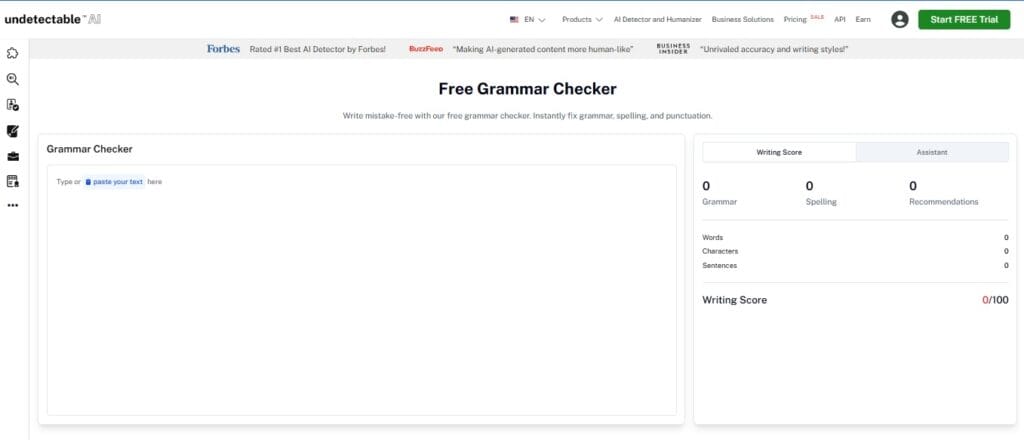That blank page can feel like a dare. You’ve got an idea, a few scenes, maybe even a character you can’t stop thinking about, but turning that spark into a full novel takes a plan.
The good news: finishing a novel isn’t about waiting for inspiration. It’s about using a process that keeps you moving even when motivation dips.
Below are 10 practical steps writers use to go from concept to a finished manuscript.
Quick tip: If you want a fast sanity check for clarity and tone, run a paragraph through our AI Checker before you keep writing.
Key Takeaways
- Writing a novel takes structure, not luck. Start by choosing your genre, defining your reader promise, and committing to a clear point of view that supports your story’s tone.
- A simple outline using the three-act structure keeps momentum, while strong characters, layered conflict, and natural dialogue give your story emotional depth and drive.
- Use sensory detail to make settings vivid, let themes emerge through choices and consequences, and refine each scene until every moment earns its place.
- AI tools like Undetectable AI can support brainstorming and editing without replacing creativity, helping polish tone, improve clarity, and keep your unique writing voice intact.
Step 1: Choose the Right Genre for Your Novel
Genre isn’t just a label. It’s a promise to the reader about the kind of experience they’re about to have.
Before you commit, ask yourself:
- What books do you finish quickly because you can’t put them down?
- What stories do you naturally daydream about writing?
- What topics do you actually enjoy researching?
Do this now: Write a one-sentence “genre promise” for your book.


Never Worry About AI Detecting Your Texts Again. Undetectable AI Can Help You:
- Make your AI assisted writing appear human-like.
- Bypass all major AI detection tools with just one click.
- Use AI safely and confidently in school and work.
Example: “A fast-paced mystery where every chapter reveals a new suspect and the ending changes everything.”
Then list 3–5 books you’d recommend to someone who would love your novel, plus 3 expectations readers have in your genre (pace, tone, typical stakes).
Helpful reference: Britannica’s overview of literary genre.
Step 2: Decide Your Point of View (POV) Early
Point of view shapes voice, suspense, and what the reader is allowed to know.
Common POV types:
- First person: Close and personal, limited to one perspective.
- Third person limited: Focused on one character at a time, with flexible narration.
- Third person omniscient: Wider lens with access to multiple characters’ thoughts.
- Second person: Rare, best for experimental fiction.
Do this now: Write the same 300–500 word scene twice (first person and third person limited). Choose the version that feels more natural and more tense.
Helpful reference: Purdue OWL guide to point of view.
Step 3: Create a Detailed Outline for Your Novel
Outlining doesn’t remove creativity. It prevents you from writing yourself into a corner. A simple outline can be a list of turning points.
When mapping out the complex narrative arc of a novel, writer’s block is a constant threat to momentum.

To overcome this, you can use our Undetectable AI’s Story Generator to immediately produce alternate plot beats and core concepts when mapping out the complex narrative arc of a novel.
Use the Three-Act Structure
- Act 1: Setup, inciting incident, and the first major decision.
- Act 2: Escalation, midpoint shift, and rising consequences.
- Act 3: Final confrontation, fallout, and resolution.
Do this now: Draft 10–15 story beats (opening situation, inciting incident, first major obstacle, midpoint shift, big setback, climax decision, and resolution).
Helpful reference: Freytag’s Pyramid (Britannica) for classic story structure.
Step 4: Build Believable Characters Readers Want to Follow

Compelling characters are driven, flawed, and forced to make hard choices.
Start with four foundations:
- Want: What they think they need.
- Need: What would actually change them.
- Fear: What they avoid or deny.
- Flaw: The habit or belief that creates problems.
Do this now: Write one paragraph answering, “What would my character never do, and what situation would force them to do it?” That pressure point is where plot gets personal.
Helpful reference: Purdue OWL: fiction writing basics.
Step 5: Create Conflict That Can Sustain a Full Novel
Conflict is the engine. Without it, scenes happen, but nothing pulls the story forward.
Your main conflict should be big enough to last a full novel, personal to the protagonist, difficult to solve without change, and connected to your theme.
Do this now: Write your conflict as a sentence: “If the protagonist doesn’t ___, then ___ will happen.”
Then layer in external conflict (events and opponents), internal conflict (fear, guilt, pride), and social conflict (relationships and reputation).
Step 6: Write Dialogue That Sounds Natural and Moves the Story
Great dialogue earns its place. Ideally, each line raises the stakes, reveals character, creates friction, or forces a decision.
Dialogue checklist:
- Cut greetings and filler unless tension lives there.
- Let characters interrupt, dodge, or change the subject.
- Use subtext: what they mean versus what they say.
- Add action beats so it doesn’t read like floating heads.
Do this now: Read your dialogue out loud. If you wouldn’t say it, rewrite it until it sounds like something a real person might say under pressure.
If a section reads stiff or overly formal, do a quick rewrite pass with Undetectable AI and then tweak it so it still sounds like you.
Step 7: Make Your Setting Feel Real (Without Over-Explaining)
Setting is more than scenery. It shapes what characters notice, fear, and value.
Use sensory detail with purpose:
- One sound that interrupts the moment.
- One smell that anchors memory or mood.
- One texture or temperature the character reacts to.
- One visual detail that signals status, danger, or comfort.
- One emotional response from the POV character.
Do this now: Write a 150-word setting snapshot using all five senses. Keep only the details that affect mood, decisions, or tension.
Step 8: Let Theme Emerge Through Choices and Consequences
Theme isn’t a lesson. It’s the question your story keeps circling, whether you name it or not.
Do this now: Write your theme as a question (not a slogan).
Example: “What are you willing to sacrifice to become who you want to be?” Then build scenes that force your character to answer it.
Step 9: Use AI as a Brainstorming and Revision Partner
AI can help when you’re stuck or when a paragraph isn’t landing. Use it like a brainstorming partner, not a ghostwriter.
Practical ways to use it:
- Brainstorm alternate directions for a scene when you’re blocked.
- Generate stronger stakes or obstacles for the next chapter.
- Tighten sentences that feel wordy or unclear.
- Check tone consistency across chapters so the voice stays steady.
Keep the final decisions yours. Your job is to choose what belongs in your story and cut the rest.
Step 10: Revise and Edit in Layers
Revision works best when you tackle one layer at a time:
- Structure: Does the plot hold together from beginning to end?
- Character arc: Does the protagonist change in a believable way?
- Pacing: Where does it drag, and where does it rush?
- Scene edits: Does every scene earn its place?
- Line edits: Is the prose clear, specific, and not repetitive?
- Proofreading: Grammar, spelling, and continuity checks.
Do this now: Label each scene with its job (raise stakes, reveal character, create conflict, turn the plot). If a scene has no job, revise it or cut it.
Helpful reference: UNC Writing Center: revising drafts.
Enhance Your Writing with Undetectable AI
When you’re stuck on a scene or need fresh ideas, Humanizer AI within Undetectable AI can help you explore different angles.

It’s especially useful for generating character backstories, suggesting unexpected plot twists, and rephrasing awkward sentences that disrupt the flow.
To polish the final draft, use our Grammar Checker to clean up punctuation, tighten clarity, and catch small errors without changing your voice.

Undetectable AI helps your writing stay clear and original while keeping your style intact.
If you want to use AI well, treat it as an enhancement tool, not a crutch. Let it support your natural writing style without taking over the creative decisions.
Used effectively, it can help you push through writer’s block, keep your tone consistent, and refine each chapter while preserving what makes your storytelling yours.
FAQs
How long does it take to write a novel?
Many writers finish a first draft in 3–12 months depending on time, genre, and process. Consistency matters more than speed.
How many words should a novel be?
Word count varies by genre, but many adult novels land around 70,000–100,000 words. If you’re unsure, aim for a range your genre typically supports and adjust after revisions.
How do I write dialogue that doesn’t sound fake?
Read it aloud, cut filler, and make sure each line creates tension, reveals character, or forces a choice. If it still sounds stiff, run the snippet through AI Humanizer to smooth the phrasing without changing the meaning.
Try Undetectable AI with just one click on the widget below and let your creativity flow seamlessly!
Ready to Start Your Novel?
Writing a novel is a journey, and every writer’s path looks different.
These steps aren’t rules set in stone. They’re tools you can use, mix, and adapt as you go.
Remember, the best writing is authentic writing. Tools like Humanizer can help polish rough spots, but your voice is what makes the story worth reading.
Start your novel today, and let your voice show up on every page, even in the messy first draft.
Ready to ensure your writing stands out?
Try Undetectable AI to refine clarity and flow while keeping your voice intact.
